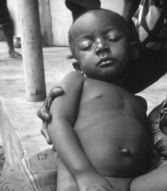|
The history of AIDS (Acquired Immunodeficiency Syndrome), with timelines, photos, and links to resources on the Internet. Endeavoring to raise public awareness through understanding.
|
|
2000-2004: The Elusive Quest for an HIV Vaccine According to the International AIDS Vaccine Initiative, "Only an AIDS vaccine can end the HIV/AIDS pandemic." With AIDS killing worldwide more people than any other infectious disease, 40 million people are living with the disease, and nearly all those will die within the next twenty years. 95% of all new infections occur in developing countries. Prevention has slowed the spread, but not arrested it. Treatment programs are costly and complex in the short term, and subject to side effects and viral resistance in the long term. If smallpox was eradicated in 1977 with an effective vaccine, then "an AIDS vaccine is possible." "Developing an AIDS vaccine to save lives and economies will be one of the world's greatest achievements." Source: International AIDS Vaccine Initiative With HIV's spread showing no signs of slowing -- 5 million people were newly infected in 2003 with 14,000 new infections daily or 600 new infections hourly -- the need for an HIV vaccine may even be greater, since in 2003, "almost five million people became infected with HIV, the greatest number of infections in a given year since the beginning of the epidemic." Source: International AIDS Vaccine Initiative As recent as February 24, 2003, VaxGen, Inc. "announced initial results from the first of its three-year, multi-national, randomized, double-blind, placebo-controlled Phase III trials of AIDSVAX (rgp120) to prevent HIV infection. The study did not show a statistically significant reduction of HIV infection within the study population as a whole, which was the primary endpoint of the trial." Source: VaxGen, Inc. The failure of VaxGen's vaccine trial was consistent with the failure of every other attempt thus far, and it had been the "world's most advanced human vaccine experiment." Before the end of 2003, the testing of another HIV vaccine would begin in South Africa, where 10% of the population is infected with HIV. Source: Wired News South Africa suffers from a death rate of about 600 to 1,000 people a day from AIDS related complications; and, it is where South African President Thabo Mbeki publicly questioned the safety of anti-AIDS drugs and whether HIV was the cause of AIDS at the 13th International AIDS Conference in Durban, South Africa on July 9, 2000. Source: CNN According to a November 3, 2003 CNN account, "Human HIV vaccine trial begins," the South African testing of an experimental HIV vaccine would contain for the first time, "genetic material from the HIV strain most prevalent in South Africa." At the time of that writing, about two dozen other HIV vaccine experiments were being conducted; but, no previous trials had ever proved successful. Tim Tucker, head of the South African AIDS Vaccine Initiative, predicted that even if successful, "it would be at least ten years before an effective vaccine was ready for distribution." Source: Wired News 2005: Using Bacteria to Protect Against HIV In Wired News, an article "Anti-HIV Bacterium Isolated?" by Rowan Hooper was posted 02:00 AM Apr. 20, 2005 PT, suggesting that hope for an answer to HIV infection may be nearer. Researcher Lin Tao from the University of Illinois at Chicago's dentistry college and colleagues
The History of AIDS © 2005 |

